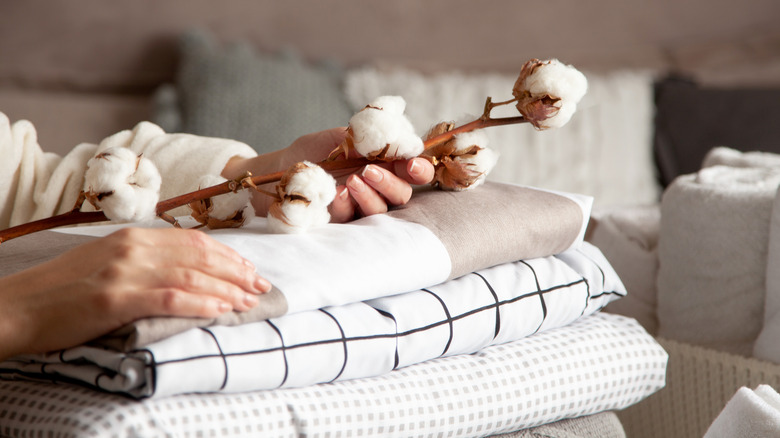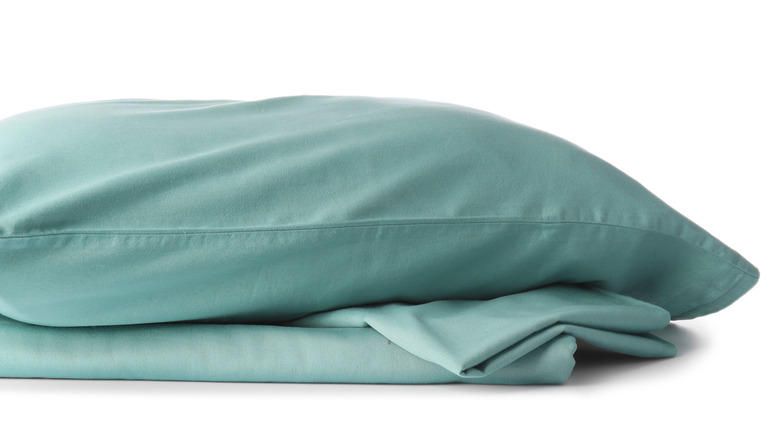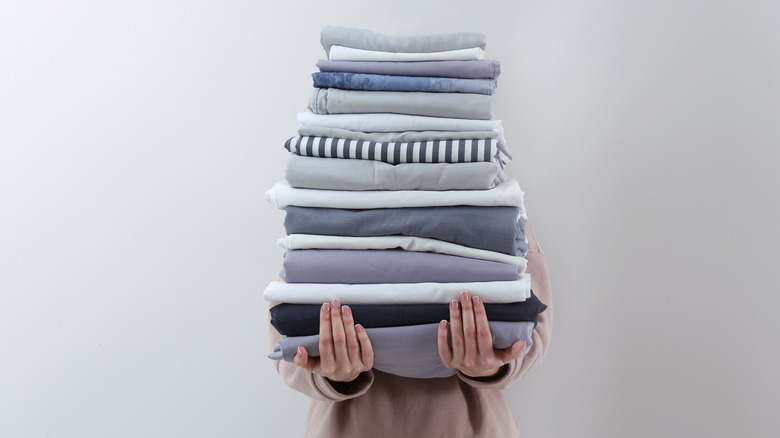Does Thread Count Really Matter With Your Sheets?
Shopping for new sheets tends to be a mind-boggling, overwhelming experience. Prices can range from $15 to $200 or more per set, depending on the quality (via U.S. News). And quality isn't so easy to determine when the packaging is loaded with buzzwords like cooling, thread count, and cotton blend. Once you decide on the type of fabric and its knit or weave style, you're still faced with the question of thread count. What does that even mean anyway?
According to Peacock Alley, thread count is a complex issue that has been hijacked by the bedding industry as a marketing tool. In fact, the higher the thread count, specifically anything over 600, is likely to be a gimmick. Here's why ... Peacock Alley says it depends on the quality of materials used and the type of weave that matters. A lower-quality multi-ply yarn can be advertised as having a higher thread count but will yield a rougher texture and can actually decrease the strength of the fabric. However, thread count shouldn't be discounted completely because, within the range of 200 to 600, it tells a bit about the weight and feel you can expect from the bed sheets.
Fabric and weave type make a difference
One of the most common fabrics for bed sheets, according to Sleepopolis, is cotton from natural cotton plants. Other options include Egyptian/Pima cotton, which is a smoother product with a stronger weave, and Tencel, which is made from eucalyptus and is moisture-wicking. Brushed cotton/flannel is warmer, while bamboo is cooling. You can also buy sheets made of synthetic polyester, a softer polyester called microfleece, modal made from beech trees, linen made from flax plants, and silk made by silkworms. Each type of fabric has a unique texture and weight with specific care instructions that are important to follow.
Weave also has a big impact on the quality of the sheet. The most common type of weave is percale, which has a criss-cross pattern that is strong and lightweight but does not always have the softest feel. Other weaves include twill (diagonal), sateen (more surface fibers), jersey (knitted, soft and stretchy fabric), patterned (brocade or damask), and dobby (usually a dot or stripe pattern).
Get the lowdown on thread counts
Thread count is determined by the number of woven threads, both vertically (called warp) and horizontally (called weft), within 1 inch of fabric, explains Ben's Brands for Less. So, a 300-thread count sheet has 150 weft and 150 warp threads for a total of 300. It's important to note that some sheets, such as silk and flannel, are measured by weight rather than thread count.
Sleepopolis says thread count pertains mostly to sheets made with cotton, and it only really matters with single-ply yarn. Thread count can also apply to bamboo and linen sheets. A sheet will feel more luxurious if it's made with long staple fibers even if the thread count is low, while one made with multiple short fibers will tout a higher thread count, resulting in a lower-quality product.
Nectar Sleep says the best thread count for cotton and percale weave is 200 to 400, while Egyptian cotton should be between 300 and 400. In addition, bamboo is best between 300 and 500, sateen is ideal at 300 to 600, and linen has the lowest thread count at 80 to 140 per square inch. Linen's thread count is a bit misleading because linen threads, according to Bed Threads, are naturally thicker than cotton, so it takes fewer linen threads to create a luxurious feel. Therefore, linen sheets are usually measured by weight using grams per square meter (GSM) rather than thread count. The higher the GSM, the heftier the fabric.


